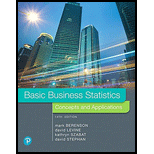
A Computer information systems professor is interested in studying the amount of time if takes students enrolled in the introduction to Computers course to write a program in VB.NET. The professor hires you to analyse the following results (in minutes), from a random sample of nine students:

a. At the 0.05 level of significance, is there evidence that the population
b. Suppose that the professor, when checking her results, realize that the fourth student 51 minutes rather than the recorded 15 minutes to write the VB.NET program. At THE 0.05 level of significance, reanalyse the question posted in (a), using the revised data. What will you tell the professor now?
c. The professor is perplexed by these paradoxical results and requests an explanation from you regarding the justification for the difference in your findings in (a) and (b). Discuss.
d. A few days later, the professor calls to tell you that the dilemma is completely resolved. The Original number 15 (the fourth data value) was “correct� and therefore your finding in (a) are being used in the article she is writing for a computer journal. Now she wants to hire you to compare the results from that group of Introduction to Computers students against those from a sample of II computer majors, the sample mean 8.5 minutes, and the sample standard deviation is 2.0 minutes. At the 0.05 level of significance, completely analyse these data. What will you tell the professor?
e. A few days later, the professor calls again to tell you that a reviewer of her article wants her to include the p-values for the “correct� result in (a). in addition, the professor inquires about an unequal-variances problem, which the reviewer wants her to discuss in her article. In your own words, discuss the concept of p-value and also describe the unequal-variances problem. Then, determine the p-value in (a) and discuss whether the unequal-variances problem had any meaning in the professor’s study.
Want to see the full answer?
Check out a sample textbook solution
Chapter 10 Solutions
EBK BASIC BUSINESS STATISTICS
- 19. Let X be a non-negative random variable. Show that lim nE (IX >n)) = 0. E lim (x)-0. = >arrow_forward(c) Utilize Fubini's Theorem to demonstrate that E(X)= = (1- F(x))dx.arrow_forward(c) Describe the positive and negative parts of a random variable. How is the integral defined for a general random variable using these components?arrow_forward
- 26. (a) Provide an example where X, X but E(X,) does not converge to E(X).arrow_forward(b) Demonstrate that if X and Y are independent, then it follows that E(XY) E(X)E(Y);arrow_forward(d) Under what conditions do we say that a random variable X is integrable, specifically when (i) X is a non-negative random variable and (ii) when X is a general random variable?arrow_forward
 Glencoe Algebra 1, Student Edition, 9780079039897...AlgebraISBN:9780079039897Author:CarterPublisher:McGraw Hill
Glencoe Algebra 1, Student Edition, 9780079039897...AlgebraISBN:9780079039897Author:CarterPublisher:McGraw Hill Holt Mcdougal Larson Pre-algebra: Student Edition...AlgebraISBN:9780547587776Author:HOLT MCDOUGALPublisher:HOLT MCDOUGAL
Holt Mcdougal Larson Pre-algebra: Student Edition...AlgebraISBN:9780547587776Author:HOLT MCDOUGALPublisher:HOLT MCDOUGAL College Algebra (MindTap Course List)AlgebraISBN:9781305652231Author:R. David Gustafson, Jeff HughesPublisher:Cengage Learning
College Algebra (MindTap Course List)AlgebraISBN:9781305652231Author:R. David Gustafson, Jeff HughesPublisher:Cengage Learning


